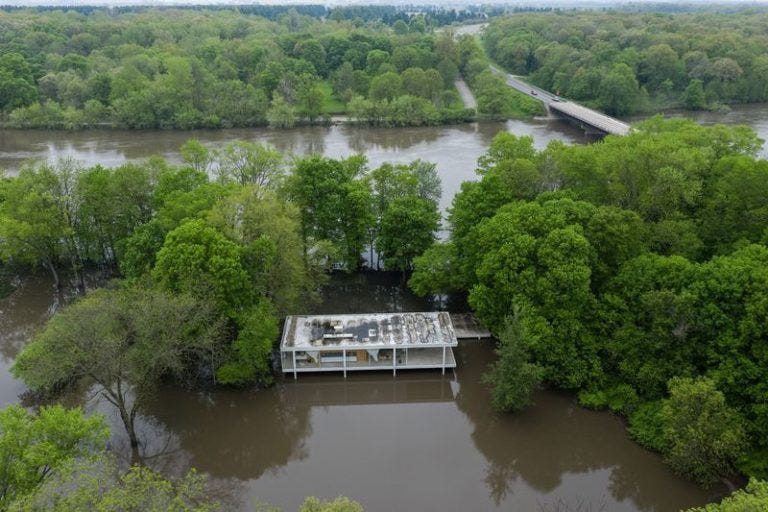First version published @ Ribbonfarm on May 26, 2020.
On May 18, 2020, architecture’s overlong twentieth century was brought to a symbolic close with the simultaneous (second) postponement of the Venice Biennale and the annual flooding of the Farnsworth House. The latter is an object lesson on the failed state of architecture in the evolving situation.
For precedent: a segue on European Modernism, the International Style was introduced as an itinerant dog-and-pony show that took off at MoMA in 1932 and wrapped six years later. Courtesy of ringmasters H.R. Hitchcock and Philip Johnson, this grand tour―and its overshadowing sideshow of a catalogue―proved to be an early and completely masterful meme-building exercise.
The International Style can be summarised in three talking points―volume, regularity, flexibility―with numerous corollaries abutting its truth values concerning materials, construction techniques and the relationship of form to function. It also carried a universalist pretence that subverted place to language, whilst suggesting a peculiar timelessness. Despite eventual pushback by Postmodernism and other stylistic retorts, the Internationalist standard has persisted as a powerful floating signifier in the collective and professional imaginations.
Completed in 1951 as a one-room retreat parallel to the Fox River near Plano, Illinois, the Farnsworth House marks a first culmination in the Miesian American project. Though many of its design decisions are inspired and attuned to site, Modernist hubris raised its head with Mies’ choice to turn the house into an impending allegory by having it raised on a floodplain, even if on stilts, and despite the estate having far less submersible areas. The house is thus 5.3 ft above ground and began to flood almost immediately, with water reaching the interiors as early as 1954.
The gesture Johnson celebrated as a display of “safe danger” is a gimmick of sublime falsification. A clear―because transparent―boundary was drawn between the architectural addition and a surrounding landscape that was expected to comport itself: inside and out can dissolve into each other to spectacular effect, provided the outdoors behaves.
Mies referred to the house’s framing of nature as bestowing the latter with “more profound significance.” Though it would survive the black maple that once loomed above its intermediate travertine terrace, the Farnsworth House is clearly at the mercy of the very elements and forces it first trained its gaze upon through a glass lightly. A Modernist masterpiece it may be, but it’s in no way timeless.
Behold, the will of the epoch translated into space.
A riff on Stanley Tigerman’s Titanic, with the Farnsworth House in lieu of Crown Hall.
Model of Le Corbusier’s Ville Savoye from Modern Architecture: International Exhibition. [MoMA Exh. #15 Feb 9-Mar 23, 1932. The Museum of Modern Art, New York. Photographic Archive. Its curators established the tradition of having historians and theorists collate, then coopt, entire architectural movements.]
The Farnsworth House, in the Fall. Photo by Victor Grigas, 2013. Wikipedia.
The Farnsworth House, after the Fall. Photo by Zbigniew Bzdak, May 19, 2020.







